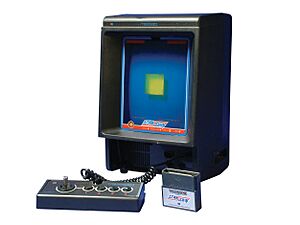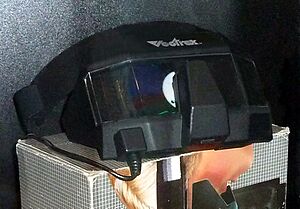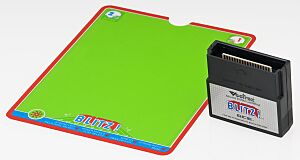Vectrex facts for kids

A Vectrex and its controller
|
|
| Developer | Smith Engineering |
|---|---|
| Manufacturer | General Consumer Electronics (1982–83) Milton Bradley Company (1983–84) |
| Type | Home video game console |
| Generation | Second generation |
| Release date |
|
| Introductory price | US$199 (equivalent to $600 in 2022) |
| Discontinued | February 1984 |
| Media | ROM cartridge |
| CPU | Motorola MC68A09 @ 1.5 MHz |
| Memory | 1 KB |
| Display | 9-inch cathode-ray tube (CRT) |
| Graphics | Vector-based |
| Sound | AY-3-8912 |
| Controller input | 2 controller ports |
| Weight | 6.8kg (15lbs) |
The Vectrex is a special kind of home video game console. It was the only one ever made for homes that used a "vector display" screen. This means it drew images using lines instead of tiny dots like a regular TV.
Smith Engineering developed the Vectrex. General Consumer Electronics (GCE) made and sold it. It first came out in North America in October 1982. Then, it arrived in Europe and Japan in 1983. Later, Milton Bradley bought GCE and took over selling the Vectrex. Bandai helped release the system in Japan.
Unlike other game systems back then, the Vectrex didn't need a TV. It had its own built-in screen that showed black and white images. A controller with a wire could fold into the console's base. Games came with clear plastic sheets called "overlays." You put these over the screen to add color to the black and white graphics.
Extra accessories included "3D Imager" goggles and a "light pen." The light pen let you draw right on the screen. A game called Mine Storm, which was like the arcade game Asteroids, was already built into every Vectrex.
John Ross from Smith Engineering first thought of the Vectrex in 1980. He imagined it as a small handheld game called "Mini Arcade." But as they worked on it, it became a tabletop system. Strong early sales led Milton Bradley to buy GCE. However, sales soon dropped because of the video game crash of 1983. The Vectrex was stopped in early 1984.
Even though it didn't sell well, people liked the Vectrex. They praised its games, unique graphics, and built-in screen. Many thought it was one of the best consoles at the time. The Vectrex was also the first console to have a 3D accessory. A color handheld Vectrex was planned later, but it was too expensive to make. Also, the Nintendo Game Boy became very popular, so the idea was dropped.
Contents
History of the Vectrex Console
The idea for the Vectrex came from John Ross at Smith Engineering. He and his team found a small screen and wondered if they could make a game with it. They created a demo that drew lines on a screen using sound signals. This demo led to the "Mini Arcade" idea, which was supposed to be a handheld game. But as they showed the idea around, it grew into a tabletop system with a nine-inch screen.
General Consumer Electronics (GCE) got the rights to the system in 1981. After a quick period of making the hardware and games, the Vectrex was shown on June 7, 1982. This happened at a big electronics show in Chicago. It was first sold in seven cities in October for $199. By early 1983, it was sold all over the country. The first sales were so good that Milton Bradley bought GCE in early 1983.
Milton Bradley had more money, which helped the Vectrex launch in Europe by mid-1983. It also came out in Japan through a deal with Bandai. But the video game crash of 1983 made supporting the Vectrex a big mistake for Milton Bradley. They even cut the price by 25% and then 50% to try and sell more units. In February 1984, Milton Bradley announced they were stopping the Vectrex. They had lost $31.6 million on it. All new game development was canceled.
The company sold off all its remaining consoles and accessories to discount stores. They were sold for much less than their original price. By May 1984, Milton Bradley joined with Hasbro, and support for the Vectrex ended.
Before the Vectrex was stopped, a new version with a color screen was planned. After Smith Engineering got the rights back, they thought about making a handheld Vectrex. But Nintendo's Game Boy was coming out, so they stopped those plans. In the mid-1990s, Jay Smith, who led Smith Engineering, allowed people to create new games and hardware for free. He also let people copy the original Vectrex games for free, so owners could get them easily.
How the Vectrex Works
Inside the Vectrex Console
The Vectrex uses a Motorola 68A09 chip as its main brain, called the CPU. This chip runs at 1.5 million cycles per second (MHz). It has a small amount of memory: 1 KB of RAM for temporary data and 8 KB of ROM for its main programs. Games are stored on ROM cartridges that hold up to 32 KB of data.
A special chip called the General Instrument AY-3-8912 handles the sounds and reads what you do with the controller. The sound comes out of a 3-inch speaker built into the console.
The Vectrex's screen is a 9-inch black and white screen. It's a standard screen used in small black and white TVs. The Vectrex draws images by moving a beam of electrons around the screen to create lines. This is different from how a regular TV works, which draws images by scanning lines across the screen. The Vectrex has special circuits to make sure the electron beam turns off if something goes wrong. This stops the screen from getting damaged.
Early Vectrex units had a noticeable "buzzing" sound from the speaker. This buzz would change with the graphics on the screen. This was due to a small wiring issue during production. Later models fixed this, but the buzz became a unique part of the Vectrex experience for many players.
Vectrex Accessories
3-D Imager Goggles
The 3-D Imager was invented by John Ross. It made the black and white images on the Vectrex screen look like colorful 3D. The imager had a spinning disk in front of your eyes. Half of the disk was black, blocking one eye. The other half had clear red, green, and blue filters.
As the disk spun, the Vectrex drew six different images very quickly. While your right eye was covered, your left eye would see a red image, then a green, then a blue one. Then, while your left eye was covered, your right eye would see its red, green, and blue images. Only one eye saw the screen at a time. The Vectrex made sure the disk spun at the perfect speed to match the game's drawing.
The game would draw objects slightly differently for each eye. This difference, along with changing how bright objects were, made them appear to be in 3D space. Because the disk spun so fast, your brain thought it was seeing two different views of the same object. This created the amazing feeling of 3D and color.
Light Pen
The light pen let you "draw" or point directly on the Vectrex screen. It had a special sensor that could "see" the bright spot as the Vectrex drew lines on the screen. When the sensor saw the bright spot, it told the Vectrex where the pen was.
The Vectrex would draw a special pattern, like a spider web, to find the pen's exact spot. The game software would adjust this pattern as you moved the pen. This helped the system keep track of the pen's position. John Ross also invented the Vectrex light pen.
Screen Overlays
To make the Vectrex games look better, every game came with a unique clear plastic sheet called a screen overlay. These overlays didn't touch the screen directly. Instead, four tabs on the console held them in place in front of it.
These overlays had one to three colors in the play area. They made the black and white screen look like it had simple color graphics. They also helped reduce glare and flickering. Some overlays even had extra artwork and patterns to make the game world more interesting. At the bottom of each overlay, there were helpful guides for the joystick and buttons. Each overlay also showed the game's title and logo, adding a cool look to the Vectrex. While not required, these overlays really improved the visual experience of playing games on the Vectrex.
Vectrex Games
Many Vectrex games were versions of popular arcade games. This happened because of a deal with a company called Cinematronics.
A company that made drinks, Old Mr. Boston, gave out a special version of the game Clean Sweep. These games had a Mr. Boston sticker on the box. The game overlay was the same as the regular Clean Sweep one, but it had the Mr. Boston name and logo on the sides. In the game itself, the text was changed, and you controlled a top hat instead of a vacuum. Richard Moszkowski wrote the Clean Sweep game.
Vectrex Today
Since the mid-1990s, a community of hobbyists has grown around the Vectrex. These fans create new games and hardware for the system. There are also computer programs called emulators, like ParaJVE and MESS, that let you play Vectrex games on modern computers.
People have even made "Vectrex Multicart" cartridges. These allow many games to be put onto one game cartridge. Some people also make and sell brand new Vectrex games. These new games sometimes come with packaging and overlays that look just like the original ones.
New hardware has also been made for the Vectrex recently. This includes a new light pen with buttons, so you don't need a second controller. There's also a special part you can add to fix the famous "buzzing" sound from the system's audio.
See also
 In Spanish: Vectrex para niños
In Spanish: Vectrex para niños
- Microvision
- C1 NES TV
- List of commercial failures in video gaming
- List of Vectrex games
Images for kids









